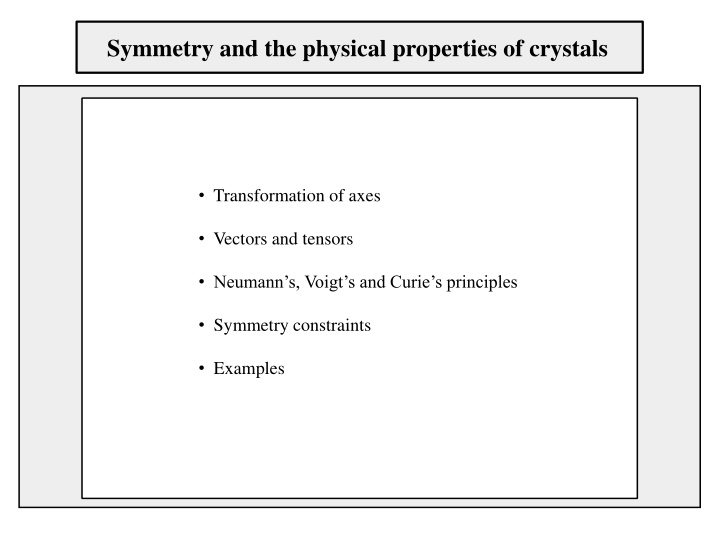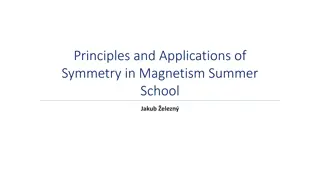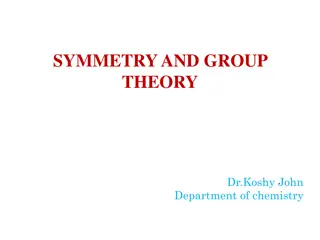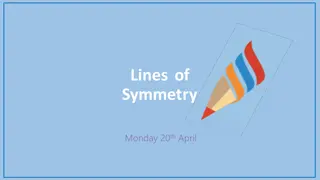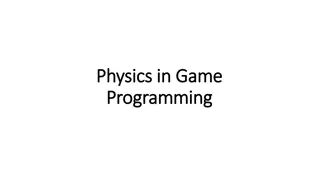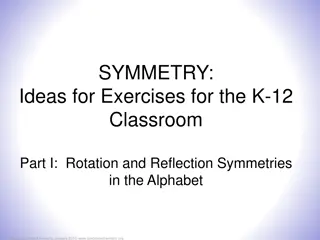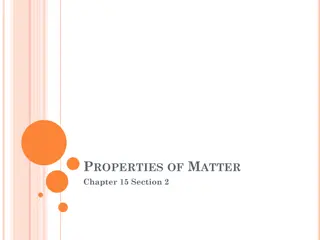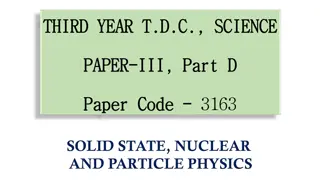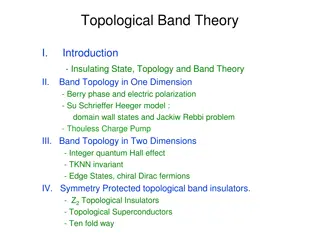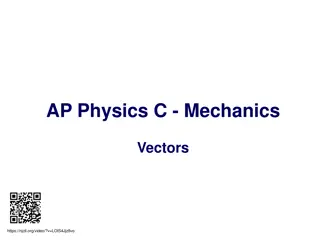Symmetry and Physical Properties of Crystals: Transformation and Vectors
The intricate world of crystals through symmetry principles, transformation of axes, and the role of vectors and tensors in understanding their physical properties. Dive into examples and constraints guiding these concepts, including Neumann's, Voigt's, and Curie's principles. Uncover the link between direction properties and anisotropy in crystals and how tensors of various ranks play a crucial role in describing materials. Delve into topics like stress and strain tensors, Voigt notation, and the transformation of axes and tensors, all crucial for understanding the behavior of crystals in response to stimuli.
Download Presentation

Please find below an Image/Link to download the presentation.
The content on the website is provided AS IS for your information and personal use only. It may not be sold, licensed, or shared on other websites without obtaining consent from the author.If you encounter any issues during the download, it is possible that the publisher has removed the file from their server.
You are allowed to download the files provided on this website for personal or commercial use, subject to the condition that they are used lawfully. All files are the property of their respective owners.
The content on the website is provided AS IS for your information and personal use only. It may not be sold, licensed, or shared on other websites without obtaining consent from the author.
E N D
Presentation Transcript
Symmetry and the physical properties of crystals Transformation of axes Vectors and tensors Neumann s, Voigt s and Curie s principles Symmetry constraints Examples
Transformation of axes x3 transformation matrix x2 x1 ij direction cosines Einstein summation convention
Vectors and tensors anisotrophy general attribute of crystals dependence on direction properties of materials: link between an independent variable stimulus (vplyvy) and a dependent variable response (odozvy) the variables and the proportionality factors that relate them can be tensors of various rank
Vectors and tensors temperature T scalar zero-rank tensor intensity of electric field E, current density i vectors tensors of rank one pyroelectric coefficient pi p vector tensor of rank one P polarization vector electrical conductivity s can be described by one number ? in general form s = sij; 9 = 32components (6 independent) second-rank tensor
Transformation of tensors vectors axes For transformation of a vector the same matrix has to be used as for the axes for a second-rank tensor in the frame of the new axes x therefore
Transformation of tensors in extended form for third-rank tensor
Stress tensor tenzor naptia Force per unit area [Pa] mechanical equilibrium normal components Stress tensor is symmetric shear components
Strain tensor tenzor malch deformci l0 xi l0+ l extension per unit length Strain tensor is symmetric according to definition x2 for homogeneous deformation x1
Voigt notation introduced for symmetric second-rank tensors simplification for stress indices 11 1 22 2 33 3 23 4 13 5 12 6 for strain
Higher-rank tensors In general, the relationship between a quantity represented by an m-rank tensor and a quantity represented by an n-rank tensor involves a tensor of rank m+n with 3m+ncomponents. Piezoelectricity Stress applied to certain crystals may develop an electric moment whose magnitude is proportional to the applied stress d is the stress tensor is the piezoelectric modulus third-rank tensor
Hooks law general form S compliance tensor tenzor poddajnosti C stiffness tensor tenzor tuhosti S and C 4th-rank tensors written in Voigt notation
Effect of symmetry pyroelectricity electrical conductivity thermal conductivity permittivity permeability piezoelectricity elasticity material tensors are reduced due to the crystal symmetry
Effect of symmetry Important questions should be answered before starting the experiment How many values of some physical parameter should be measured? Which crystal directions give the simplest measurements? Which directions should give duplicate results? the knowledge of symmetry (point group) and Neumann s and Voigt s principles can help to answer these questions
Neumanns principle The symmetry elements of any physical property of a crystal must include all the symmetry elements of the point group of the crystal, where K denotes the symmetry group of the crystal, GT is the symmetry group of the tensor representing the physical property. The point group K of the crystal must be a subgroup of the symmetry group GT of tensor of the physical property. The magnitude of a particular physical property measured along a specific direction is unchanged when the material is rotated, reflected or inverted into a new orientation corresponding to one of the symmetry elements of its point group.
Voigts principle According to Neumann's principle the tensor representing any physical property should be invariant with regard to every symmetry operation of the given crystal class. The condition of invariance reduces the number of the independent tensor components, since it signifies relationships between the tensor components.
Application of Neumanns principle property described by a second-rank tensor monoclinic crystal with point symmetry group symmetry elements corresponding matrices
Application of Neumanns principle final form
Application of Neumanns principle property described by a second-rank tensor tetragonal crystal with point symmetry group x3 x2 x1
Application of Neumanns principle if s is symmetrical final form
Important remarks Tensors have the simplest form if the coordinate axes are chosen in the directions of the crystal axes with highest symmetry All second-rank symmetrical tensors can be diagonalized by an appropriate choice of coordinate axes Physical meaning of the tensor components e. g. Ga2O3 electrical conductivity s electric field E = (E1, 0, 0) conductivity in the direction of axis x
Property T in a given direction n general direction given by unit vector n = (c1, c2, c3) c1 direction cosines of n transform T from x, y, z to new coordinates n, y , z for symmetrical tensors
Curies principle When certain causes produce certain effects, the symmetry elements of the causes must be found in their effects. The symmetry of the crystal subject to an external influence preserves only the symmetry elements that are common to both the crystal and the perturbing influence. P is the symmetry group of the perturbed crystal, K and G are the symmetry groups of the crystal and of the external influence, respectively.
Curies principle symmetry of disturbed crystal symmetry of influence symmetry of crystal uniaxial compression electric field E(0, 0, E) mm2 mmm
Examples Pyroelectricity the effect cannot exist in a crystal possessing a centre of symmetry if the crystal possess a unique direction, the polarization vector P lies always along this direction can be present only in crystals with symmetry described by one of ten polar point groups 1, 2, 3, 4, 6, m, mm2, 3m, 4mm and 6mm Tourmaline, trigonal crystal, symmetry group 3m Temperature change 1 C produces a polarization 4 x 10-6C/m2K that is equivalent to the intensity 740 V/cm
Examples Piezoelectricity of quartz point group 32 x3 x2 x1 has no effect is always zero
Examples stiffness tensor for hexagonal crystals stiffness tensor for cubic crystals axes parallel to
Stress and strain in thin films Plane stress isotropic materials cubic crystals hexagonal crystals are there shear stresses acting on the dislocations in epitaxial layers?
Shear stresses in fcc lattices cubic unit cell slip plane (111) slip direction new coordinates x , y , z transform the stress tensor
Types of vectors position vector, radius vector differentiation derivatives velocity electric field intensity all these vectors are polar vectors they transform according to rule for proper as well as improper operations
Types of vectors angular momentum vector product magnetic field B these vectors are axial vectors or pseudovectors they violate the standard transformation rule for improper operations! antisymmetrical second-rank tensor solution
Example higher-order derivatives tensor of reciprocal effective mass constant energy surfaces - ellipsoids role of local symmetry longitudinal effective mass for Si transverse effective mass for Si
